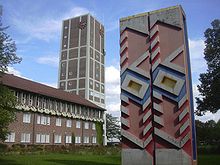Kornwestheim town hall
The Kornwestheim town hall tower was built in 1935 in Kornwestheim . It not only serves as a town hall tower, but also as a water tower and a clock tower . At 48 meters high (61 meters with the flagpole on top) it is a landmark of the city that is visible beyond the city limits.
history
From 1890 to 1933 the population of Kornwestheim increased fivefold to over 10,000. Both the administration and the supply facilities had to be adapted to the changed conditions. In 1912, the community decided to build a new town hall, which began on the corner of Stuttgarter Strasse and Eberhardstrasse (now Friedrich-Siller-Strasse). After the outbreak of the First World War , construction was interrupted, not resumed later and the construction site was finally leveled. The water supply had been secured since 1917 by feeding Danube water from the state water supply , but the capacity of the water reservoir built in 1896 in the Salonwald (near Ludwigsburg ) was visibly no longer sufficient.
After financial problems had long prevented a solution, they were addressed again in 1933 under Mayor Alfred Kercher and an architectural competition was announced. Paul Bonatz (including the master builder of Stuttgart Central Station ) won this award with his suggestion to combine the two projects and build the town hall tower as a water tower. An elevated location on Stuttgarter Strasse, at that time on the southern outskirts, was chosen as the location. This guaranteed the necessary water pressure and set an example for the city's subsequent expansion to the south.
The construction was secured by loans from the Reich administration, started in October 1933 and inaugurated in November 1935. In addition to the water tower, it also consisted of an adjacent administration building. The height of the tower is 48 meters, the foundations are 8 meters deep, and the elevated tank integrated into the tower holds 800 m³ of water.
Only 20 years later, the city's population had doubled again, and in addition to the industrial plants, the American troops stationed in Kornwestheim ensured high water consumption. Therefore, in 1954/55, two earth tanks with 2,200 m³ each were sunk into the ground on the square in front of the town hall. From these the water is pumped into the town hall tower. Since 1958 Kornwestheim has also been getting its water from the Lake Constance water supply . In the 1990s the administration wing was expanded and architecturally integrated into the existing building complex.
Town hall door
Noteworthy is the door on the south side of the town hall tower, which is older than the tower itself. It was built for the previous building, which began in 1914 but was not completed. In December 1915, mayor Friedrich Siller proposed to the municipal council that the door intended for construction be designed as a symbol of war. The Stuttgart painter Pfennig was commissioned with the design. The door made of oak and linden wood provided space for 8,000 nails, which citizens could hammer into the door in return for a donation. Such nail figures were a widespread method of collecting donations for charitable or patriotic purposes during World War I.
With black and gold-colored nails, four iron crosses , the year 1916 and the elements of the royal Württemberg coat of arms (Staufer lions and stag sticks) are depicted on the door ; the black nails together with the red background color result in the Württemberg state colors . The total cost of the door and nails was 1,235 marks.
The door was nailed on March 5, 1916 at the betting area. Depending on the size, the nails could be purchased for between 20 pfennigs and 3 marks. A total of 4448 marks u. a. for the German Red Cross together. The donors signed a memorial book that is now kept in the city archives. The heads of some nails are provided with letters, the initials of the donors or of soldiers in the field.
After the war, the construction of the town hall, which was interrupted in 1914, was not continued. The door was kept and used in the new town hall that was then built in 1935.
Traditional
Every year around Christmas time, a Christmas tree is set up on the tower's viewing platform . The lights shine from the 1st of Advent up to and including Epiphany.
See also
Web links
literature
- Jens U. Schmidt, Günther Bosch, Albert Baur: Water towers in Baden-Württemberg. Land of the water towers. Regia-Verlag, Cottbus 2009, ISBN 978-3-86929-002-7 .
Individual evidence
- ↑ Marco Nimsch: The further expansion of the water supply in Kornwestheim. In: Kornwestheimer Geschichtsblätter. No. 8, 1988, ZDB -ID 1207024-5 , pp. 55-58.
- ^ City administration Kornwestheim (ed.): 1200 years Kornwestheim. City administration, Kornwestheim 1981.
- ^ City of Kornwestheim (ed.): City of Kornwestheim, city guide. City of Kornwestheim, Kornwestheim 2003, ISBN 3-00-012039-4 .
- ↑ Marco Nimsch: The door of the town hall tower. In: Hie good Württemberg. Vol. 44, No. 1, 1993, ZDB -ID 126281-6 , p. 16.
- ↑ Roland Schuldt: The town hall door is a real curiosity. In: Kornwestheim history sheets. No. 8, 1998, pp. 89-90.
Coordinates: 48 ° 51 ′ 36 ″ N , 9 ° 11 ′ 7 ″ E



